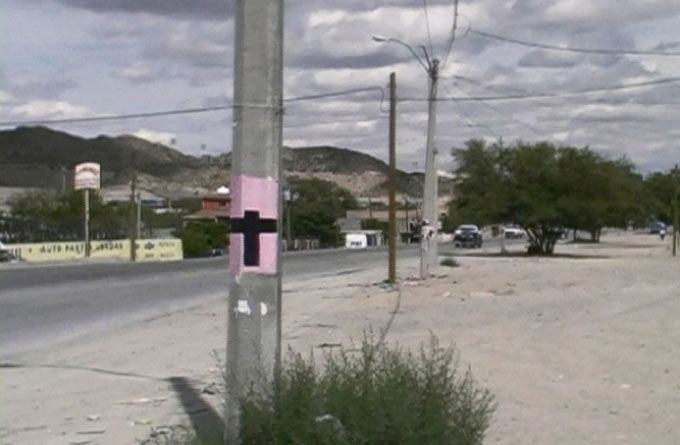Each month, Creative Time Reports asks an artist or collective to list five favorite projects around the world. For the inaugural edition, we turned to Ghana ThinkTank, an international network of think tanks devoted to generating strategies that resolve local problems in the “developed” world. The Ghana ThinkTank’s organizers are Christopher Robbins, John Ewing, and Maria Del Carmen Montoya.
Ghana ThinkTank notes: “We should point out that these stories were all heard second- or third-hand, and we’ve had difficulties corroborating them online, so they could simply be inspirational stories. We guess we’ll take the inspiration, then.”
1. Vetevendosje
Last summer, while working in Mitrovica, a town in Northern Kosovo, we were struck by what appeared to be a graffiti war between Serbs and Albanians living on opposite sides of a river that divided the town. Some signs were conciliatory (for instance, a Serbian nationalist symbol was converted into a smiley face), while others complained of foreigners meddling in their political affairs. And then there were those who recognized that, in the end, the ruling class was probably the real problem, not one another.

Ghana ThinkTank and Aaron Krach, Graffiti in Mitrovica, 2011. On the left is the text in Albanian and translated into English on the right.
We soon discovered that much of this graffiti was the work of Vetevendosje (which literally means “self-determination”), a political activist group that opposes the United Nations administration mission in Kosovo, regarding it as a form of colonization by “Internationals.”
Although we are not affiliated with their politics, we were still inspired by some of their tactics. In particular, we were moved by stories of how they tried to push the writing of their new nation’s constitution out from behind closed doors of rooms full of people who hadn’t even grown up in the region! In one case, Vetevendosje plastered the exterior of the U.N. building in which the constitution was being written with blank wheat-pasted posters that asked passersby “What do you want your constitution to contain?” People stopped and wrote their own constitution—a collection of demands from the street.
2. Dancing on Bridges During the Bombing of Belgrade
This one is sort of an archival ‘Top Five”—but after bringing up Vetevendosje, we feel like we need to round the list out with a mention of an inspiring Serb action we heard about when we lived in Serbia. At the end of the Balkan Wars of the 1990s, when NATO strikes intensified in Serbia, there were many complaints of civilian sites being targeted (Ostružnica and Grdelica Bridge were two of the more infamous examples). As the story goes, people in Belgrade responded to the onslaught by painting large targets onto their clothing and throwing enormous dance parties on bridges and other likely civilian targets.

A still from video camera installed on one of the two missiles fired by NATO warplanes that struck a civilian passenger train while crossing a bridge at Grdelica Gorge in Serbia, on April 12, 1999. It was these sorts of attacks that prompted the bridge parties.
3. The “Pillars of Creation” from the Eagle Nebula
These finger-like protrusions of dust and gas are approximately four light years tall. (By comparison, our entire solar system is only about two light years in diameter.) And, here’s the freaky part: they’re gone. A supernova destroyed them six thousand years ago, but since they’re seven thousand light years away from Earth, it will take another millennium before we see them disappear.
They were found in 1995, even though they no longer existed. Despite this, we can still see them. Somehow that strikes a chord with the target shirt dance party.

Jeff Hester and Paul Scowen, Pillars of Creation, 1995. Photo courtesy of NASA.
4. Nuestras Hijas de Regreso a Casa
This item is from Ghana ThinkTank member, Carmen Montoya.
I visited Ciudad Juárez often when I was child because my grandmother lived there. Whenever we were in town my mother would tell me about working at the JC Penney in El Paso when she was younger. She recalled that she would have to choose between eating an ice cream cone for dinner and taking the bus across the bridge to Juarez. If she spent the 10 cents on a cone, then she would have to walk home. She was young, independent, and bringing home much needed money to her family. But Juárez is a very different city now. This walk is unthinkable for a young woman today. Since 1993, there have been a series of brutal murders of women. And while it is undeniable that both men and women suffer violent deaths in the region, the high rates and particular brutality of the murders of women and girls in Juárez attest to a gendered persecution.
Two organizations that I have had the privilege to work with—Nuestras Hijas de Regresso a Casa, a support organization founded by the families of murdered women, and Casa Amiga, Juárez’s first rape crisis and sexual assault center—continue to struggle tirelessly, with few resources, to maintain a focus on the murders despite efforts by the Mexican government to cover up and marginalize the importance of the femicide. Their work is an inspiration and demonstrates the power of human-scale intervention.

“Via Anapra,” Ciudad Juárez, Mexico. The pink cross memorializes murdered women in the city. Photo by Maria del Carmen Montoya.
5. Desert Aid from No More Deaths
The people at No More Deaths leave water in the desert for immigrants traveling on foot. They risk fines and legal convictions to provide something so basic, so simple—water without which a person would die an agonizing death under a scalding sun.

In 2009, Staton was charged with littering after putting out jugs of water intended for migrants crossing remote areas of the Sonoran desert last December in Buenos Aires National Wildlife Refuge. Photo courtesy of Unitarian Universalist Association and Walter Staton of NoMoreDeaths.org.
This piece, commissioned by Creative Time Reports, has also been published by visualMAG.

